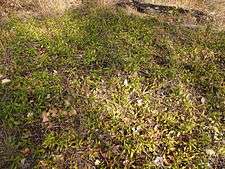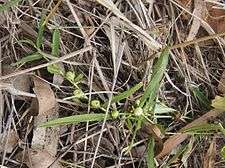Eremophila debilis
| Winter Apple | |
|---|---|
 | |
| Eremophila debilis flower and foliage | |
| Scientific classification | |
| Kingdom: | Plantae |
| (unranked): | Angiosperms |
| (unranked): | Eudicots |
| (unranked): | Asterids |
| Order: | Lamiales |
| Family: | Scrophulariaceae |
| Genus: | Eremophila |
| Species: | E. debilis |
| Binomial name | |
| Eremophila debilis (Andrews) Chinnock[1] | |
| Synonyms[2] | |
|
Myoporum debile (Andrews) R.Br. Andreusia debilis (Andrews) Vent. | |
Eremophila debilis, commonly known as winter apple or amulla, is a flowering plant in the figwort family, Scrophulariaceae and is endemic to an area extending from north Queensland to near the border between New South Wales and Victoria in Australia. It is a prostrate shrub with lance-shaped leaves and white, rarely deep mauve flowers.
Description
Eremophila debilis is a prostrate shrub with spreading stems up to 1 m (3 ft) long. It has glossy green, elliptic to lance-shaped leaves which are mostly 32–85 mm (1–3 in) long, 8–20 mm (0.3–0.8 in) wide and glabrous usually with 3 or 4 pairs of prominent teeth on the edges.[2][3][4][5][6]
The flowers are borne singly or in groups of up to 3 in leaf axils on a stalk 3.5–7.5 mm (0.1–0.3 in) long. There are 5 green, lance-shaped, slightly overlapping sepals mostly 7–10 mm (0.3–0.4 in) long. The petals are 8.5–11 mm (0.3–0.4 in) long and joined at their lower end to form a tube. The petal tube is white to pale mauve and, unlike many others in the genus, does not have spots. The petal tube and lobes are mostly glabrous on the outside but the inside of the tube is filled with soft hairs. The 4 stamens are fully enclosed within the tube. Flowering mainly occurs in spring and summer and is followed by rounded, fleshy, white to reddish purple fruits, which are 7–10 mm (0.3–0.4 in) in diameter.[2][3][4][5][6]


Taxonomy and naming
The species was first formally described by Henry Charles Andrews in 1802 who gave it the name Pogonia debilis. The description was published in The Botanist's Repository for New, and Rare Plants.[7][8] Robert Brown changed the name to Myoporum debile in 1810[9][10] and in 1992 Robert Chinnock changed the name to Eremophila debilis.[1][11] The specific epithet (debilis) is a Latin word meaning "weak"[12] referring to the decumbent stems of this species.[2]
Distribution and habitat
Eremophila debilis is widespread in eastern Queensland and New South Wales in a wide range of soils and vegetation associations,[2] often in box and white cypress communities,[3] sometimes forming dense mats.[13] It has been recorded near Boosey in Victoria. It is also present in New Zealand, thought to be the result of naturalisation.[2]
Use in horticulture
Winter apple is well known in horticulture, although often as Myoporum debile. It is suitable as a groundcover in many areas as long as the soil is reasonably well-drained. Its flowers, fruit and foliage are attractive features. It is frost hardy and in ideal conditions will layer.[5] Propagation from seed is difficult but is easy from hardened cuttings of the present year's growth.[6][14][15]
References
- 1 2 "Eremophila debilis". APNI. Retrieved 5 January 2016.
- 1 2 3 4 5 6 Chinnock, R.J. (Bob) (2007). Eremophila and allied genera : a monograph of the plant family Myoporaceae (1st ed.). Dural, NSW: Rosenberg. pp. 226–229. ISBN 9781877058165.
- 1 2 3 Chinnock, Robert J. "Eremophila debilis". Royal Botanic Gardens Sydeny: Plantnet. Retrieved 5 January 2016.
- 1 2 Carolin, Roger C.; Tindale, Mary D. (1994). Flora of the Sydney region (4th ed.). Chatswood, NSW: Reed. p. 593. ISBN 0730104001.
- 1 2 3 "Eremophila debilis". Australian Native Plants Society Australia. Retrieved 5 January 2016.
- 1 2 3 Lodder, Mark. "Eremophila debilis". Australian National Botanic Garden. Retrieved 5 January 2016.
- ↑ "Pogonia debilis". APNI. Retrieved 5 January 2016.
- ↑ Andrews, Henry Charles (1802). The Botanist's Repository for New, and Rare Plants (Volume 3). p. 212. Retrieved 5 January 2016.
- ↑ "Myoporum debile". APNI. Retrieved 5 January 2016.
- ↑ Brown, Robert (1810). Prodromus Florae Novae Hollandiae. London. p. 516. Retrieved 5 January 2016.
- ↑ Chinnock, Robert J. (1992). "New taxa and combination in the Myoporaceae" (PDF). Journal of the Adelaide Botanic Garden. 15 (1): 77–78. Retrieved 5 January 2016.
- ↑ "debilis". Wiktionary. Retrieved 6 January 2016.
- ↑ "Eremophila debilis". Flora of the Pilliga forest. Retrieved 5 January 2016.
- ↑ Wrigley, John W.; Fagg, Murray (1983). Australian native plants : a manual for their propagation, cultivation and use in landscaping (2nd ed.). Sydney: Collins. p. 87. ISBN 0002165759.
- ↑ Boschen, Norma; Goods, Maree; Wait, Russell (2008). Australia's eremophilas : changing gardens for a changing climate. Melbourne: Bloomings Books. p. 233. ISBN 9781876473655.